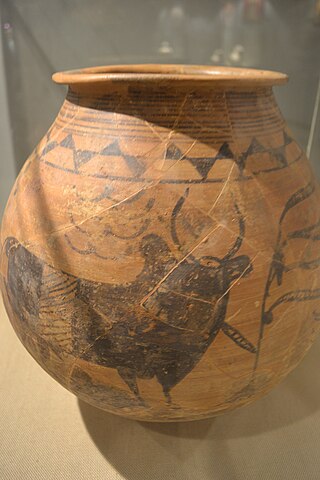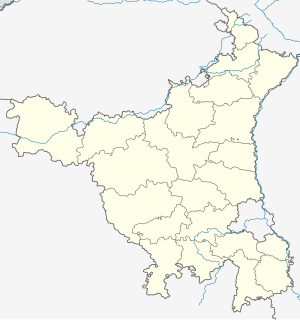
Harappa is an archaeological site in Punjab, Pakistan, about 24 km (15 mi) west of Sahiwal. The Bronze Age Harappan civilisation, now more often called the Indus Valley Civilisation, is named after the site, which takes its name from a modern village near the former course of the Ravi River, which now runs 8 km (5.0 mi) to the north. The core of the Harappan civilisation extended over a large area, from Gujarat in the south, across Sindh and Rajasthan and extending into Punjab and Haryana. Numerous sites have been found outside the core area, including some as far east as Uttar Pradesh and as far west as Sutkagen-dor on the Makran coast of Balochistan, not far from Iran.

Rakhigarhi or Rakhi Garhi is a village and an archaeological site in the Hisar District of the northern Indian state of Haryana, situated about 150 km northwest of Delhi. It is located in the Ghaggar River plain, some 27 km from the seasonal Ghaggar river, and belonged to the Indus Valley civilisation, being part of the pre-Harappan, early Harappan, and the mature phase of the Indus Valley Civilisation.
Rehman Dheri or sometime Rahman Dheri is a Pre-Harappan Archaeological Site situated near Dera Ismail Khan in the Khyber Pakhtunkhwa province of Pakistan. This is one of the oldest urbanised centres found to date in South Asia. Dated, the site is situated 22 kilometres (14 mi) north of Dera Ismail Khan. It is on the Tentative List for future World Heritage Sites in Pakistan.

Amri is an ancient settlement in modern-day Sindh, Pakistan, that goes back to 3600 BCE. The site is located south of Mohenjo Daro on Hyderabad-Dadu Road more than 100 kilometres north of Hyderabad, Pakistan.
Amri–Nal culture is attributed to Amri archaeological sites in Sindh and Balochistan provinces of Pakistan. It flourished in the 4th and 3rd millennia BC. The dual typesites are Amri and Sohr Damb area in Naal, Balochistan.

Pottery in the Indian subcontinent has an ancient history and is one of the most tangible and iconic elements of Indian art. Evidence of pottery has been found in the early settlements of Lahuradewa and later the Indus Valley Civilisation. Today, it is a cultural art that is still practiced extensively in the subcontinent. Until recent times all Indian pottery has been earthenware, including terracotta.

Nausharo is located in Balochistan, Pakistan. It is well known as an archaeological site for the Harappan period. The excavations were carried out between 1985 and 1996 by a French team of archaeologists, under the direction of Jean-François Jarrige. The other sites belonging to the same cluster are Mehrgarh and Pirak.
Banawali is an archaeological site belonging to the Indus Valley civilization period in Fatehabad district, Haryana, India and is located about 120 km northeast of Kalibangan and 16 km from Fatehabad. Banawali, which is earlier called Vanavali, is on the left banks of dried up Sarasvati River. Comparing to Kalibangan, which was a town established in lower middle valley of dried up Sarasvathi River, Banawali was built over upper middle valley of Sarasvati River.

Bhirrana, also Bhirdana and Birhana, is an archaeological site, located in a small village in the Fatehabad district of the north Indian state of Haryana. Bhirrana's earliest archaeological layers predates the Indus Valley civilisation times, dating to the 8th-7th millennium BCE. The site is one of the many sites seen along the channels of the seasonal Ghaggar river, thought by some to be the Rigvedic Saraswati river.
Kheri Jalab is a village and an Indus Valley civilization site, located in Hisar District of the state of Haryana in India.
Sotha is a village in Haryana, India.

Siswal is a village in Hisar district, Haryana, India. It located 28 km from Hisar city. It is a site of Chalcolithic age. It is a typesite for Siswal culture, dating from around 3800 BC, also known as Sothi–Siswal culture.
Mitathal is a village and Indus Valley civilization (IVC) Archaeological sites in the Bhiwani tehsil of the Bhiwani district in the Indian state of Haryana. Part of Hisar division, it lies 12 kilometres (7.5 mi) north of the district headquarters Bhiwani and 249 kilometres (155 mi) from the state capital Chandigarh. As of the 2011 Census of India, the village had 1,448 households with a total population of 7,434 of which 4,002 were male and 3,432 female.
Lohari Ragho is a village and Indus Valley civilization archaeological site, located in Hisar district of the Haryana state in India. It has 3 separate mounds, each 1 to 1.5 km apart within the peripheral suburban zone of Rakhigarhi city cite, where artifacts belonging to Mature Harappan and Sothi-Siswal cultural period have been confirmed based on filed visits. These mounds, unprotected and under risk of encroachment and threat of obliteration, are yet to be excavated, fenced, protected or conserved.
Sisai is a village situated 9 kilometres (5.6 mi) from Hansi tehsil in Hisar district in the Indian state of Haryana. The village was established by "Shisram Kaliraman"on whose name the village is named "Sisai". It is a prominent village of Kaliraman Jats and serves as headquarters of Akhil Bharatiya Kaliraman Khap. Kaliraman and Sihag are the gotras of Jats in this village.There are two panas in this village, Sisai Kaliraman and Sisai Bola. Master Chandgi Ram Pehlwan also belonged to this village. It is the largest village not having a police station. Altius and eklvya public schools are proceeding towards making this village "wrestling Hub".
Kunal is a pre-Harappan Indus Valley civilisation settlement located, just 30 km from Fatehabad City in Fatehabad district of Haryana state in India. Compared to other IVC sites, such as cities like Rakhigarhi and towns like Kalibangan, Kunal site was a village. Excavation at Kunal show 3 successive phases of Pre-Harappan indigenous culture on the Saraswati river who also traded with Kalibanga and Lothal. Kunal, along with its other contemporary sites Bhirrana and Rakhigarhi on Sarasvati-Ghaggar river system, is recognised as the oldest Pre-Harappan settlement, with Kunal being an older cultural ancestor to Rehman Dheri in Pakistan< which is on the Tentative List for future World Heritage Sites.
Karanpura is an archeological site near Bhadra city of Hanumangarh district in Rajasthan, India. It belongs with ancient Indus Valley civilization. Harappan pottery has been found after excavation.
Mirchpur is an Indus Valley civilization site and village in Narnaund, Hissar district, Haryana, India.
Sothi is an early archaeological site of the Indus Valley civilization dating to around 4600 BCE, located in the Hanumangarh District of Rajasthan, India, at a distance of about 10 km southwest of Nohar railway station.








